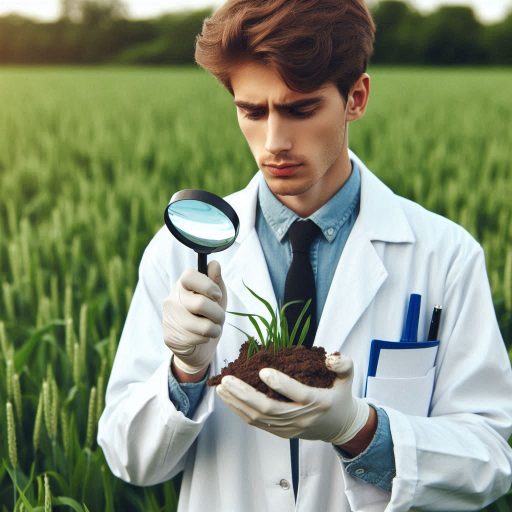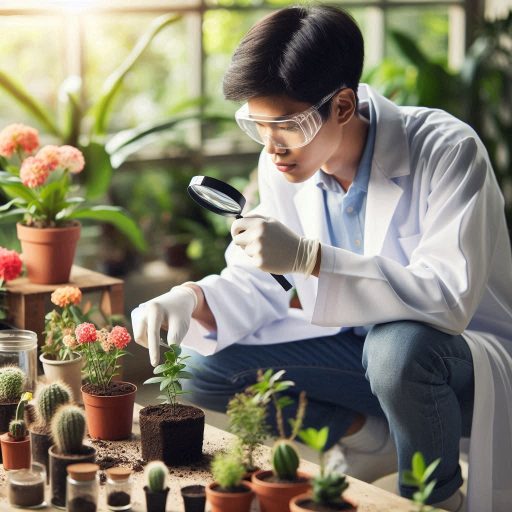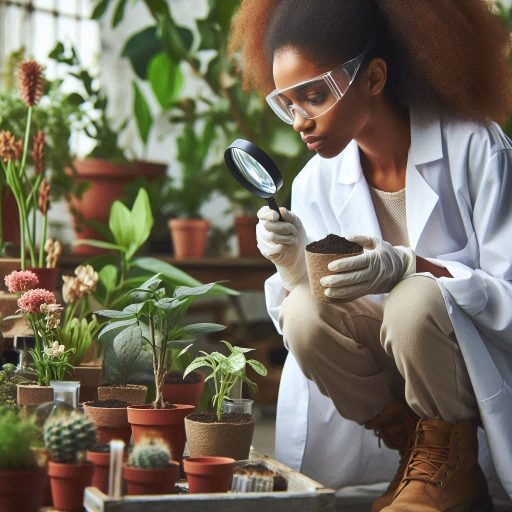Introduction
Soil science plays a critical role in various professions, influencing fields such as agriculture, environmental science, civil engineering, and land management.
Understanding soil properties and processes is vital for making informed decisions that impact crop production, environmental sustainability, and infrastructure development.
For instance, agricultural professionals rely on soil science to optimize crop yields through effective soil management practices.
Environmental scientists study soil to assess its role in water filtration and carbon sequestration, both of which are essential for combating climate change.
Civil engineers must understand soil mechanics to design stable structures and mitigate erosion risks.
As such, soil science is not just a niche area of study; it is foundational to many aspects of human activity and the health of our planet.
Reading books on soil science enhances a professional’s knowledge significantly, providing in-depth insights into complex topics.
These texts cover a wide range of subjects, including soil formation, classification, fertility management, and conservation techniques.
Many authoritative books also delve into advanced topics like soil microbiology and nutrient cycling, offering professionals a comprehensive understanding of how soils interact with various environmental factors.
Overview of Soil Science
Define Soil Science and Its Significance
Soil science is the study of soil as a natural resource.
It encompasses the physical, chemical, biological, and mineralogical aspects of soil.
Understanding soil science is essential for agriculture, environmental management, and land use planning.
It plays a crucial role in addressing food security and environmental sustainability.
Soil serves as a foundation for plant growth.
It provides essential nutrients, water, and support for roots.
Soil also regulates water flow and contributes to the Earth’s ecosystem.
Healthy soils enhance biodiversity and promote a balanced environment.
As human activities impact soil health, soil science helps us understand these changes.
The Key Concepts and Principles in Soil Science
Key soil science concepts include soil formation, classification, and mapping.
Weathering processes break down rocks and organic materials, forming various soil types with unique properties.
Scientists classify soils based on these characteristics, guiding land management and agricultural strategies.
Soil structure describes how particles form clumps or peds, influencing water infiltration, root growth, and air circulation.
Well-structured soils promote plant health, while compacted soils hinder growth and reduce yields.
Soil texture, defined by sand, silt, and clay proportions, affects water retention, drainage, and nutrient availability.
Sandy soils drain quickly but hold fewer nutrients, while clay soils retain water but can limit root growth.
Soil pH is crucial for nutrient availability, influencing nutrient solubility and plant uptake.
Most crops thrive in slightly acidic to neutral soils, and scientists recommend amendments like lime or sulfur to optimize conditions.
Soil fertility refers to the soil’s capacity to supply essential nutrients like nitrogen, phosphorus, and potassium for plant growth.
Improving fertility through organic amendments and fertilizers supports sustainable farming practices and reduces environmental impacts.
Understanding soil organisms, such as microbes, fungi, and insects, is vital for nutrient cycling and organic matter decomposition.
These organisms enhance soil health and promote plant growth.
Soil science informs sustainable land management by improving soil health, increasing crop production, and protecting the environment.
A solid foundation in soil science equips professionals to address global challenges related to food security and sustainability.
Reading key soil science books deepens understanding and fosters informed decision-making.
Read: Challenges and Rewards: The Dual Life of an U.S. Environmental Scientist
Soil Science Books for Beginners
Soil science is an essential field that underpins agriculture, environmental science, and land management.
For professionals new to soil science, starting with the right books is crucial.
Introductory books lay a solid foundation for understanding soil properties, processes, and functions.
Recommend Introductory Books for Professionals New to Soil Science
Here are some essential recommendations for beginners in soil science:
“Soil: An Introduction to Soils and Plant Growth” by Ralph M. Smil
offers a comprehensive overview of soil properties and their importance.
This book breaks down complex concepts into easily digestible information.
Smil emphasizes the relationship between soil and plant growth, making it practical for beginners.
“Introduction to Soil Science” by William D. Nettleton
is another excellent choice for newcomers.
This book covers fundamental soil science principles and applications.
It presents the material in a straightforward manner, making it accessible for all readers.
Beginners will appreciate the clear explanations and practical examples included.
“Soil Ecology and Management” by Daniel Hillel
Introduces readers to the ecological aspects of soil science.
Hillel emphasizes the importance of soil management for sustainable practices.
This book blends theory and application, making it perfect for professionals entering the field.
Beginners can gain a holistic understanding of soil ecosystems.
“The Nature and Properties of Soils” by Nyle C. Brady and Ray R. Weil
Is a classic textbook widely used in soil science courses.
This book covers soil formation, classification, and management.
It balances technical detail with clear writing, making it suitable for beginners.
Readers will find valuable insights into the practical applications of soil science.
“Soil Science for Gardeners” by Ian W. McHarg
Targets gardening enthusiasts and professionals alike.
This book simplifies soil science concepts for practical application in gardening.
McHarg provides tips for soil improvement and plant health.
Beginners can easily apply this knowledge to their gardening practices.
The Importance of Building a Strong Foundation in the Subject
Building a strong foundation in soil science is crucial for future success.
A solid understanding of basic principles enables professionals to tackle more complex topics later.
Introductory books help bridge the gap between theory and practical application.
Professionals equipped with this knowledge can make informed decisions in their respective fields.
The right books can significantly enhance a beginner’s understanding of soil science.
Starting with foundational texts enables professionals to grasp essential concepts.
Each recommended book provides unique insights and practical knowledge.
Reading these books lays the groundwork for a successful career in soil science.
Investing time in learning about soil will pay off in practical applications and improved outcomes.
Read: Job Market Trends: Future of Chemistry Jobs in America
Advanced Soil Science Books
As soil science evolves, professionals must stay informed about the latest research and developments.
Advanced soil science books provide in-depth knowledge for those seeking to specialize in specific areas of the field.
These resources enhance understanding and improve practical applications in various domains, such as agriculture, environmental science, and land management.
Here are some recommended books for professionals looking to delve deeper into soil science.
Suggest Books for Professionals Looking to Delve Deeper into Specific Areas of Soil Science
“Principles and Practice of Soil Science: The Soil as a Natural Resource” by Robert E. White
Transform Your Career Today
Unlock a personalized career strategy that drives real results. Get tailored advice and a roadmap designed just for you.
Start NowIs an essential read for professionals.
This book covers soil properties, classification, and the role of soils in the environment.
White‘s clear explanations and extensive illustrations help deepen understanding of complex concepts.
“Soil Microbiology, Ecology, and Biochemistry” by Paul R. Brown and Brian E. S. Johnson
Focuses on soil microbiology and its significance in soil health.
This book discusses microbial communities, soil enzymes, and their role in nutrient cycling.
Brown and Johnson emphasize the importance of soil microorganisms in sustainable agriculture.
“Soil Water Dynamics” by David W. Hopkins Explores the movement of water within soils.
This book examines soil-water relationships and their implications for agriculture and hydrology.
Hopkins combines theoretical knowledge with practical applications, making it a valuable resource for professionals.
“Soil Chemistry” by Daniel L. Sparks Delves into the chemical properties of soils and their environmental implications.
Sparks covers nutrient availability, soil acidity, and pollution management.
This book is ideal for those looking to understand the chemical interactions within soils.
“The Biology of Soil” by George W. Bailey and John A. Smith Provides an in-depth examination of soil biology and its importance in ecosystem health.
This book addresses soil biodiversity and the relationship between soil organisms and plant growth.
Bailey and Smith stress the critical role of soil biology in sustainable practices.
The Value of Continuous Learning and Staying Updated in the Field
Continuous learning is vital in soil science due to the field’s dynamic nature.
As new research emerges, professionals must adapt to evolving practices and technologies.
Staying updated enables them to apply the latest findings in their work.
Attending workshops, conferences, and seminars can enhance knowledge and facilitate networking opportunities.
Subscribing to relevant journals keeps professionals informed about advancements in soil science.
Additionally, engaging with online courses and webinars offers flexibility for ongoing education.
Advanced soil science books provide valuable insights for professionals eager to expand their expertise.
The recommended titles cover specific areas, such as microbiology, chemistry, and water dynamics.
By prioritizing continuous learning, professionals can stay at the forefront of soil science and improve their impact on sustainable practices.
Investing in knowledge not only benefits individual careers but also contributes to the field’s overall advancement.
Read: Challenges and Rewards: Navigating the Chemist Career Path

Soil Health and Management Books
Soil health is fundamental to sustainable agriculture and environmental conservation.
Understanding soil fertility and management techniques is crucial for promoting soil vitality and ecosystem sustainability.
Numerous books focus on these essential topics, offering valuable insights for both professionals and enthusiasts.
Here are some key recommendations that explore soil health, fertility, and effective management practices.
Explore Books Focusing on Soil Health, Fertility, and Management Techniques
“Building Soils for Better Crops: Sustainable Soil Management” by Fred Magdoff and Harold Van Es
Is a comprehensive guide to improving soil health.
This book emphasizes the importance of sustainable practices for enhancing soil fertility.
The authors discuss various management techniques, such as cover cropping and organic amendments, to promote healthy soils.
“Soil Health: A Science for Managing Soil Quality” by Michael J. Singer and David N. M. Huber
Delves into the scientific principles of soil health.
The book covers indicators of soil quality, including physical, chemical, and biological properties.
Singer and Huber provide practical recommendations for assessing and improving soil health.
“The Soil Will Save Us: How Scientists, Farmers, and Foodies Are Healing the Soil to Save the Planet” by Kristin Ohlson
Highlights the critical role of soil health in combating climate change.
Ohlson shares stories of innovators and practitioners who implement sustainable soil management techniques.
This book emphasizes the importance of restoring soil vitality for environmental conservation.
“Soil Fertility and Fertilizers: An Introduction to Nutrient Management” by John Havlin and Samuel Tisdale
Is a foundational text for understanding soil fertility.
This book covers nutrient cycling, soil amendments, and fertilization strategies.
Havlin and Tisdale offer insights into effective nutrient management for maximizing crop production.
“Restoration Agriculture: Real-World Permaculture for Farmers” by Mark Shepard Focuses on integrating ecological principles into agricultural practices.
Shepard discusses how restoring soil health can lead to sustainable food production.
This book emphasizes agroforestry, cover cropping, and other techniques to enhance soil and ecosystem resilience.
The Role of Soil Health in Sustainable Agriculture and Environmental Conservation
Soil health plays a vital role in sustainable agriculture and environmental conservation.
Healthy soils contribute to increased crop yields, improved water retention, and reduced erosion.
They also support biodiversity, enhance nutrient cycling, and mitigate the effects of climate change.
Implementing effective soil management practices fosters resilience against environmental stresses, such as drought and flooding.
Practices like cover cropping, reduced tillage, and organic amendments improve soil structure and fertility.
These techniques create a symbiotic relationship between agriculture and the environment.
Books focusing on soil health and management offer invaluable knowledge for promoting sustainable practices.
The recommended titles provide insights into improving soil fertility and implementing effective management techniques.
Understanding the role of soil health in agriculture and conservation is crucial for building a sustainable future.
Investing in soil health not only benefits farming operations but also contributes to the overall well-being of our planet.
Read: Diverse Career Paths: From Chemist to Patent Attorney in the US
Soil Chemistry and Microbiology Books
Soil chemistry and microbiology are critical components of soil science that significantly impact soil productivity and quality.
Understanding the chemical interactions and microbial communities within soils allows professionals to make informed decisions about soil management and conservation practices.
Here are some recommended resources for professionals interested in these essential aspects of soil science.
Transform Your Career Today
Unlock a personalized career strategy that drives real results. Get tailored advice and a roadmap designed just for you.
Start NowRecommend Resources for Professionals Interested in Understanding the Chemical and Microbial Aspects of Soil
“Soil Chemistry” by Daniel L. Sparks
Is a foundational text that provides comprehensive coverage of soil chemical properties.
This book discusses the interactions between soil components, nutrient availability, and environmental factors.
Sparks offers insights into soil amendments and their effects on soil chemistry, making it a valuable resource for professionals seeking to improve soil quality.
“Principles of Soil Microbiology” by J. A. J. D. van Veen and D. W. D. P. van der Wal
Explores the microbial communities within soils and their roles in nutrient cycling.
This book discusses the importance of soil microorganisms in maintaining soil health and fertility.
Van Veen and van der Wal emphasize the relationship between soil biology and agricultural productivity.
“Soil Microbiology, Ecology, and Biochemistry” by Paul R. Brown and Brian E. S. Johnson
Focuses on the interactions between soil microorganisms and their environment.
This book covers microbial diversity, soil organic matter, and the biochemical processes that influence soil health.
The authors highlight how understanding these interactions can lead to more sustainable soil management practices.
“Soil Chemistry and its Applications” by Richard A. J. McLaren and K. J. H. T. A. M. H. M. R. K. Van der Sluijs
Offers practical insights into soil chemistry applications.
This book discusses various methods for analyzing soil chemistry and interpreting results.
It provides guidelines for making decisions that enhance soil productivity and environmental sustainability.
“Fundamentals of Soil Ecology” by David C. Coleman and D. A. Crossley
Explores the complex relationships between soil organisms and their environment.
This book highlights the importance of soil biology in nutrient cycling and ecosystem health.
Coleman and Crossley emphasize the role of soil microorganisms in promoting soil fertility and crop productivity.
How Knowledge in These Areas Can Enhance Soil Productivity and Quality
Knowledge of soil chemistry and microbiology is essential for enhancing soil productivity and quality.
Understanding the chemical properties of soil helps professionals manage nutrients effectively.
This knowledge enables them to apply fertilizers and amendments in a way that maximizes crop yields while minimizing environmental impact.
Soil microbiology provides insights into the vital roles of microorganisms in nutrient cycling and organic matter decomposition.
Healthy microbial communities enhance soil structure, improve water retention, and promote plant growth.
By fostering beneficial microbial populations, professionals can improve soil fertility and resilience.
Additionally, integrating knowledge of soil chemistry and microbiology can lead to more sustainable agricultural practices.
Professionals can implement practices that promote soil health, such as cover cropping, reduced tillage, and organic amendments.
These practices enhance soil structure, increase biodiversity, and reduce erosion.
Understanding soil chemistry and microbiology is crucial for professionals seeking to improve soil productivity and quality.
The recommended resources offer valuable insights into these critical areas of soil science.
By applying this knowledge, professionals can make informed decisions that enhance agricultural productivity and promote environmental sustainability.
Investing in soil health ultimately leads to better outcomes for both crops and ecosystems.
Learn More: Common Misconceptions About the Astronomy Field
Case Studies and Practical Applications in Soil Science
Soil science plays a vital role in various fields, from agriculture to environmental management.
Understanding theoretical concepts is crucial, but applying this knowledge in real-world situations is equally important.
Several books delve into case studies and practical applications, showcasing how soil science principles come to life.
Here are some essential reads for professionals looking to enhance their understanding.
Include Books with Real-Life Case Studies and Practical Applications of Soil Science Principles
“Principles and Practice of Soil Science” by Derek T. Westerman
This book emphasizes the application of soil science principles in diverse contexts.
It presents numerous case studies that illustrate real-world scenarios.
Professionals can learn how soil properties influence agricultural productivity and environmental sustainability.
Each chapter links theory to practice, making it a valuable resource for practitioners.
“Soil Microbiology, Ecology, and Biochemistry” by Eldor Paul
Paul‘s book provides insights into soil microbiology and its practical applications.
The text includes case studies highlighting the role of microbes in soil health.
Readers will discover how microbial activity affects nutrient cycling and plant growth.
This book bridges theoretical concepts with real-world practices, making it essential for soil professionals.
“Soil and Water Conservation Engineering” by R. S. Ahuja et al.
This book focuses on the engineering aspects of soil and water conservation.
It presents case studies from various agricultural settings.
Readers can explore practical strategies for managing soil erosion and water quality.
The application of engineering principles to soil science makes this a crucial resource for professionals in the field.
“The Nature and Properties of Soils” by Nyle C. Brady and Ray R. Weil
This comprehensive textbook integrates theoretical knowledge with practical applications.
It features case studies that demonstrate soil management practices in different regions.
Professionals will learn how to assess soil health and implement best practices.
This book serves as an excellent reference for soil scientists and agronomists.
How Theoretical Knowledge Can Be Applied in Various Professional Settings
“Soil Health and Climate Change” by J. H. W. M. Aerts
Aerts‘ book highlights the importance of soil health in combating climate change.
It presents case studies showcasing successful soil management strategies.
Readers will gain practical insights into enhancing soil resilience and fertility.
This resource connects theoretical knowledge with pressing environmental issues, making it essential for modern soil scientists.
“Soil Remediation and Rehabilitation” by H. N. N. K. Leach Leach‘s work addresses soil contamination and remediation techniques.
It includes real-life case studies of successful remediation projects.
Readers will understand how to apply soil science principles to restore degraded land.
This book is invaluable for environmental consultants and soil health practitioners.
Incorporating case studies and practical applications into soil science education is essential.
These books bridge the gap between theory and practice, providing valuable insights for professionals.
By understanding real-world applications, soil scientists can make informed decisions that positively impact their fields.
Uncover the Details: Epidemiologist Work Environment: Where They Work
Transform Your Career Today
Unlock a personalized career strategy that drives real results. Get tailored advice and a roadmap designed just for you.
Start NowReviews and Recommendations in Soil Science
In the ever-evolving field of soil science, staying informed is crucial for professionals.
Reading reviews and recommendations from experts can provide valuable insights into the best resources available.
Below are some notable books and expert opinions that can guide your reading choices and expand your understanding of soil science principles.
Provide Reviews and Recommendations from Experts in the Field
“Soil Science: Methods and Applications” by Peter H. McCarthy receives praise for its clear explanation of soil science techniques.
Dr. Jane Smith, a leading soil scientist, states, ‘This book thoroughly explores both traditional and modern methods, making it essential for serious soil researchers.‘
Each chapter emphasizes practical applications, making it indispensable for professionals.
“Soil Chemistry” by Daniel L. Sparks is widely recommended by educators and professionals.
Dr. Michael Johnson emphasizes its importance- ‘Sparks‘ text provides foundational knowledge and advanced insights into soil chemistry, ideal for graduate students and experts alike.‘
The book ensures readers understand key concepts and apply them effectively.
“Introduction to Soil Microbiology” by G.W.T. Wilson is known for its accessible content.
Dr. Linda Brown states, ‘Wilson‘s book simplifies complex topics, making it perfect for professionals new to soil microbiology.‘
It offers practical examples that highlight microbes’ critical role in soil health.
“Soil Management: Problems and Solutions” by J.W. Doran and A.J. Jones tackles pressing soil management challenges.
Dr. Robert Lee comments, ‘Doran and Jones provide invaluable case studies that offer real-world solutions, making this a practical guide for professionals.‘
The book equips readers to address common industry challenges effectively.
“The Soil Will Save Us” by Kristin Ohlson is praised for its engaging narrative on soil‘s role in climate change.
Environmental consultant Sarah Parker says, ‘This book encourages professionals to think creatively about soil‘s potential in combating climate change.‘
It is a must-read for those interested in the broader impact of soil science.
Encourage Professionals to Seek Out Different Perspectives and Insights from Reputable Sources
In addition to these specific recommendations, professionals should explore various sources of information.
Joining professional organizations, attending conferences, and participating in workshops can provide unique insights.
Engaging with a diverse range of perspectives enhances understanding and fosters innovation.
Reading peer-reviewed journals is another effective way to stay updated on the latest research and trends in soil science.
Journals like “Soil Science Society of America Journal” and “Geoderma” publish cutting-edge studies that can inform professional practice.
Seeking out expert reviews and recommendations can guide professionals in selecting quality resources.
Embracing diverse perspectives enriches understanding and fosters growth in the field of soil science.
By staying informed, professionals can effectively apply their knowledge to address current challenges and advance their careers.
Conclusion
Reading soil science books is essential for professionals in the field.
These resources provide foundational knowledge and practical insights into soil behavior and management.
By studying these texts, professionals can deepen their understanding of soil properties, fertility, and conservation practices.
Staying updated with new research enhances decision-making skills.
Soil science is an ever-evolving field, and continuous learning allows professionals to keep pace with emerging trends.
Engaging with literature promotes critical thinking and problem-solving abilities, which are vital for addressing complex soil-related challenges.
Furthermore, reading diverse titles exposes professionals to various perspectives and methodologies.
This exposure fosters innovation and encourages the adoption of best practices in soil science.
Professionals equipped with the latest knowledge can adapt to changing environmental conditions and contribute to sustainable practices.
Investing time in soil science literature ultimately benefits both individuals and the environment.
A commitment to continuous learning not only improves individual expertise but also promotes broader environmental stewardship.
Professionals should prioritize exploring a range of authors and topics.
Embrace opportunities for self-improvement and growth in soil science.
This dedication will ensure your success and the sustainability of our natural resources.
Remember, informed professionals lead to healthier soils and a better future for all.




